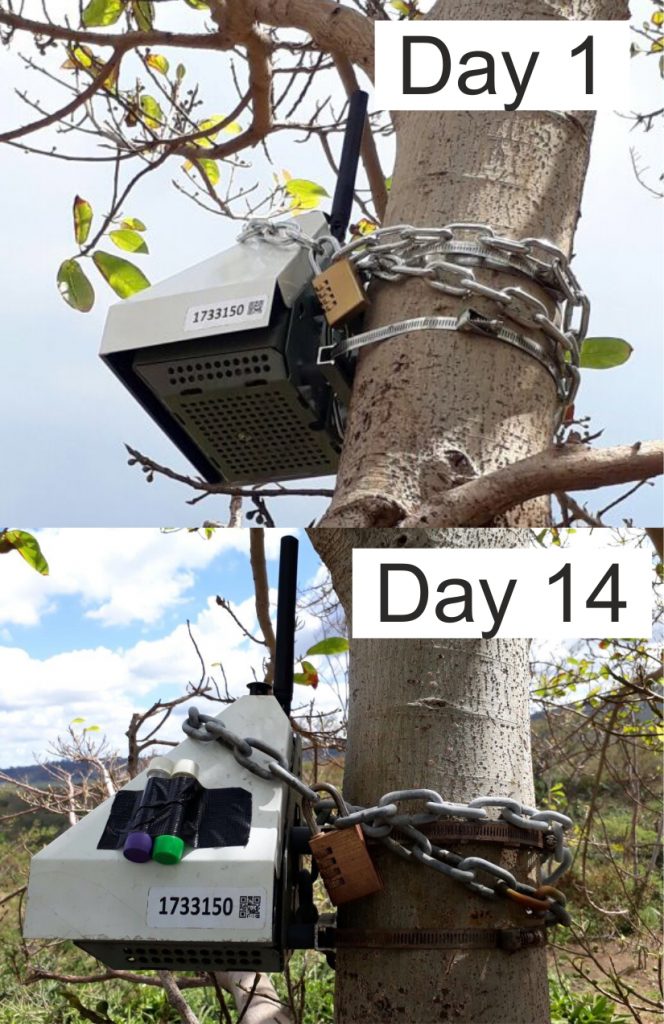
The last decade has been inundated with reports of environmental disasters impacting the lives of billions of people around the world. While news coverage of floods, hurricanes, earthquakes or wild fires are always accompanied with spectacular images of destruction that emphasise the speed at which they strike, a myriad of slow and latent hazards have been left in the shadow of the public attention.
One of those overshadowed and underestimated hazards is environmental pollution caused by persistent volcanic emissions. Our project, UNRESP, seeks to develop early-warning procedures for events during which air pollution reaches hazardous levels, using an approach that bridges volcanology, environmental sciences, history, human geography and sociology.
We based our project at Masaya volcano in Nicaragua. Although Masaya has a spectacular lava lake (above video) it does not produce ash explosions, instead it quietly and persistently loads the local environment with gases and aerosol particles. This poses a huge air pollution hazard – Masaya’s annual SO2 emissions in 2006 matched those of the entire UK but were released from a point source. Masaya’s volcanic air pollution is estimated to impact at least 50,000 people in rural communities, and it is also periodically transported to the cities of Managua (population 2.2 million) and Masaya (population 150,000) where it mixes with anthropogenic air pollution.
Our interdisciplinary team, composed of researchers from the UK and Nicaragua, travelled out to Masaya this year to find out how this volcano impacts local communities. This was by no means my first trip to Masaya (it was the first volcano I visited as a PhD student a decade ago). But it was the first time I was going to concentrate on the nearby communities.

Figure 1: PM2.5 levels (daily-mean) in two communities in the vicinity of Masaya volcano, measured March – June 2017. PM2.5 pollution fluctuates greatly on short time scales and reaches ‘High’ and ‘Very high’ levels on several occasions. The air pollution index (Low, Moderate, High and Very high) is that used in the UK and is shown here for reference only as no index exists for Nicaragua.
We installed a small network of air quality monitors in the communities living near Masaya. This was the first air quality network in Nicaragua as a whole! We were able to show for the first time how the volcano impacts air quality: how intense the air pollution episodes can get, how long they last and how frequently they occur – all of these are factors that impact human mortality and morbidity. We saw that the volcano particularly enhances the concentration of atmospheric particulate (PM2.5) (Figure 1). These extremely high but short-lived pollution spikes demonstrate the need for permanent monitoring and public advisories so that their impact can be mitigated.
We were also interested in more than the physical side of the hazard. We went out into local communities and tried to learn what it’s like to live every day with this volcano. We unearthed and documented a huge amount of resilience practices – little things that people do to counteract the impact of the volcano on their lives. These things may seem trivial at first glance but are based on community knowledge going back centuries. For example, the acidity of the volcanic plume causes incredibly fast rusting of metal (Figure 2) so people have learned to build houses are built without using any nails (Figure 3). Women explained how they treat their kitchen appliances in a particular way. The quality of the rain water (the acidity of which can be as low as pH 2 during the most severe pollution episodes!) is assessed by how it reacts with soap. And, perhaps most importantly, people know what kind of crops they can grow, and when. The volcanic plume is a killer to most crops (like coffee), but people have discovered that pineapple and dragon fruit grow exceptionally well.
Figure 3: Houses in El Panama village, only 2 km from Masaya’s active crater. They are built without using nails due to the extremely fast corrosion. The roofs are held in place with wood and rocks. Note that the heavy ‘cloud’ overhead is the volcanic plume.This first ‘digging’ of our foundation phase has yielded more questions that it has answered. We are very keen to continue with our ongoing collaboration and expand it even further.
On a more personal note, the most valuable thing I learned from this trip was something that I’ve objectively always known but never felt to the same extent before. Volcanoes like Masaya are so much more than the petrology of their rocks, or the enrichment factor of their emissions, or the refractive index of their ash. They are deeply intertwined with the lives of the people around them, and to those people it’s their real life and not just a scientific publication. Let’s not ever lose sight of that.
Blog written by Evgenia Ilyinskaya (University of Leeds). You can follow the project on Twitter @UNRESPproject.
UNRESP project is funded by GCRF Building Resilience programme. Note all data discussed in this blog are unpublished and have not been peer-reviewed.



